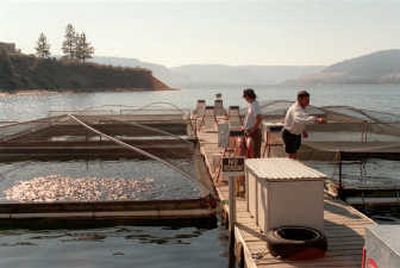NET GAINS

The guardian angel of the Lake Roosevelt trout net-pen project is retiring this week on a high note for fish and fishermen.
“We’ve been short on fish the past two years, but next spring we should be releasing more rainbows than we’ve ever raised in a season,” said Gene Smith, coordinator for 14 years of the trout-rearing program funded by the Bonneville Power Administration.
BPA is required to enhance Columbia River fisheries to help mitigate losses of salmon caused by Grand Coulee Dam. Releasing hatchery-produced fish each summer after spring runoff is the only way to provide a reliable trout fishery in the fluctuating water levels behind the dam.
In 1995, BPA officials decided to pay a coordinator to manage and expand a net-pen rearing program that had already been proved effective in the previous 10 years. They tapped Smith, who had just retired from 25 years of coaching at Reardan High School.
Smith had fished the lake for three decades. The communication skills he used in coaching Reardan to four State B basketball championships were invaluable. And he was a biology teacher to boot.
By word of mouth and a few picnics, Smith expanded the project with nearly 70 volunteers sporting a wealth of skills, including carpentry and welding. When Smith took over, there were already 18 volunteer-managed net pens along the 150-mile reservoir. Two years later, they were maintaining 43 rainbow pens.
In October, the pens are stocked with trout fry, which are fed all winter and released in May.
The project released only 34 pens of fish last year, but this year Smith expects to have 45 pens full of trout maintained by about 40 volunteers.
Since taking charge, Smith has spearheaded the release of roughly 5.8 million rainbows into Roosevelt to the delight of anglers, who catch an average of 150,000 mature trout a year.
Millions of kokanee also have been released in the program, which partners with the Spokane Tribe and the Washington Department of Fish and Wildlife. However, three years ago, the program stopped raising kokanee in net pens in favor of direct releases from the Spokane Tribal Hatchery.
About 400,000 kokanee will be released this year, said Tim Peone, hatchery manager.
The project is operating on $144,000 a year, up from $96,000 a year in 1995, according to Scott Simms, BPA spokesman in Portland. Costs include the coordinator’s $2,562 a month salary.
This week, Smith is transferring his position to Vic Melin of Hunters. Melin has been one of the project’s many volunteers for eight years.
Fishing for trout or kokanee has been excellent in most of the years under Smith’s watch, with two notable exceptions:
“The “big flushes” during the flood years of 1996 and 1997 each washed as many as 800,000 trout and kokanee through Grand Coulee Dam and down the Columbia, leaving few fish for anglers in Lake Roosevelt.
“Roughly 60 percent fewer than normal trout were released in 2006 and 2007 as state and tribal hatchery managers dealt with diseases and complying with new standards to produce sterile fish. In addition, several net pens were damaged by winter storms.
Anglers have noticed fewer fish in the lake this summer, and some blame Grand Coulee Dam operations for flushing a higher percentage of fish down the river this season.
Said Donley, “We’re at half or less than half of the fish normally in the reservoir. Some are caught, some are eaten by walleyes, others swim over the dam and others disappear for other reasons. The fish remaining in the reservoir are distributed in patches. When you find a school, instead of having several hundred fish as it like it would a few years ago, it might have only 30 or 40 fish.”
“I hate to blame flushing,” Smith said. “We live with that year in and year out. Managing the flows is very complicated. Mainly, we’ve had fewer fish. But the beauty of the net-pen program is that if things go bad for some reason, we can recover the fishery in a year.
“Our goal has been to release more than 500,000 rainbows a year, but the last two years we’ve been down by 300,000 to 340,000,” said Chris Donley, Washington Department of Fish and Wildlife district biologist.
“This year, however, we’re in great shape,” Smith said. “Barring any problems with disease, we’ll be raising more than 700,000 rainbows this winter for release next spring — more than ever before.
“Next year at this time, fishermen should be finding lots of 13-15 inch rainbows.”
All of these fish will be fin-clipped to indicate they are sterile net-pen reared trout, Peone said.
Another 60,000 or more native redband rainbows are scheduled for release from the state’s Sherman Creek Hatchery as part of a program to restore the species in the upper reaches of the reservoir.
“I’ve loved this project and working with the volunteers to do something good for fishermen,” Smith said. “I’m almost 70, but I’m not disappearing. I believe in what we’re doing. I’m just stepping back to be a volunteer instead of the coordinator.”